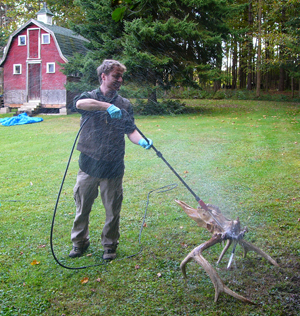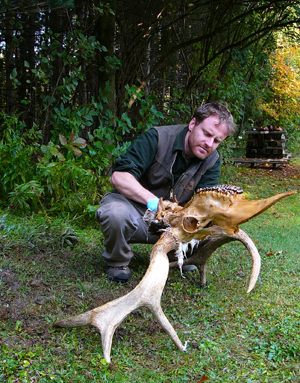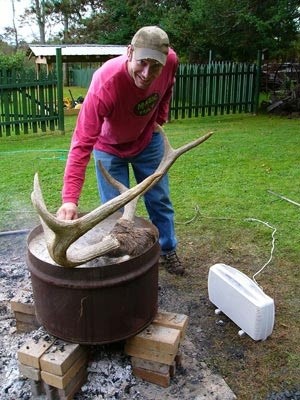My friend J was lucky enough to draw a Vermont moose tag last year; luckier still to take a strange-looking-but-in-a-good-way bull on the fourth day of the season. The bull was 10.5 years old, as evidenced by an odd, gnarly, almost elk-like rack (when cervids get older, their horns start to shrink, just like bones in people; as for the age part, hunters age their animals by counting the growth rings in a front tooth).
This particular set of horns didn’t quite lend itself to traditional taxidermy, so J opted for a “Texas-mount” – the colloquial term for a full skull and horns arrangement – as opposed to the stuffed head of Country Bear Jamboree fame, or, the simpler scalp-and-horns display favored by most frugal New Englanders.
Problem was, after 8 straight hours of butchering and freezing moose meat last October, neither J or I had the energy for taxidermy. He promised himself he’d get to the head later – you know how that goes. In any case, when I called him up last Saturday to ask if I could borrow the skull for a talk I was giving at a local middle school, he said “sure,” but in the long, drawn-out way you’d tell a buddy they can borrow your truck when you know it has a flat tire.

Turns out leaving a severed moose head on the ground beneath a pin cherry tree for 11 months does little to remove the flesh. Worse, the skin sort of mummifies and turns to leather. The brain matter was gone, and the whole things was riddled with critters – maggots, flesh-eating bugs, even an olfactorily-challenged mouse who was living in the brain-cavity (talk about your low-rent district) – still, these animals had done little to help with the cleaning process.
If we had known better, we would have consulted the Northern Woodlands archives and found the feature story on skull prep in the Summer 2006 issue. This informative article, written by Leighton Wass, details everything you need to know about preserving and displaying skulls. We would have learned about dermestid beetles – little bugs you can buy at biological supply companies – which would have done most of the work for us. But, of course, hindsight is always 20/20.

We did finally get J’s skull clean, but only after cutting down a 40 gallon drum and boiling the head over a coal-fired campfire for 8 hours. When the meat was loose enough, we used a pressure-washer to blow off the remaining matter. A little gross, I’ll grant you, but not all bad. There’s a certain charm in sitting around a campfire with a good friend, boiling down a skull on a crisp October morning.
I remember reading books, as a boy, about life on 19th century whaling schooners, where deck hands stoked roaring fires beneath bubbling try-pots, the blood and gore and blubber boiling and smoking and stinking. As powerful as that image is, I can’t image it smelling any worse than the stank coming off of that moose skull.


